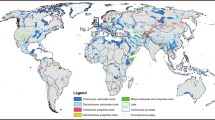Abstract
Contaminant plumes in the strictest sense only occur in granular media. Defined as contaminated groundwater masses spreading by diffusion and hydrodynamic dispersion, plumes take the shape of a feather, from which the name derives. While plume-like masses may appear in a uniformly and densely fractured medium, they rarely develop in karst aquifers—though they are frequently alleged to exist. Unfortunately, a karst pseudoplume is often incorrectly interpreted to mean that monitoring wells are functioning appropriately; this misinterpretation can divert attention from gross contaminant movement to more distant locations. The highly heterogeneous and anisotropic character of karst aquifers, and the convergent nature of the conduit flow systems within them severely limit plume formation. What is often mistaken for a plume in these rocks may derive from three processes which will be discussed in this paper. First, the contaminant may move as a true plume in a granular overburden and find entry into the solution modified fractures of the bedrock at numerous points. There may be groundwater flow connections between these modified fractures, but such flow is most likely to be convergent rather than divergent. Second, when volatile contaminant vapors spread in an unsaturated epikarst, they may dissolve in percolating vadose groundwater and contaminate phreatic groundwater below. Third, solution conduits in karst are subject to regular and sometimes extreme increases in hydraulic head caused by concentrated quick-flow from precipitation events. Contaminated water in a conduit may be forced by these increases into the surrounding permeability structure, similar to temporary bank storage adjacent to a stream. When the head in the conduit declines, water returns to the conduit, leaving a fraction of the dissolved contaminants behind. With each successive rain event, the contaminant may be driven further into the surrounding rock.




Similar content being viewed by others
References
Benson RC, La Fountain LJ (1984) Evaluation of subsidence or collapse potential due to subsurface cavities, In: Proceedings, first multidisciplinary conference on sinkholes. Orlando, Fla., Balkema, Rotterdam, pp 201–215
Crawford NC (1988) Karst ground water contamination from leaking underground storage tanks; prevention, monitoring techniques, emergency response procedures, and aquifer restoration. In: Proceedings, second conference on environmental problems in karst terranes and their solutions. Dublin, Ohio, National Water Well Association, pp 213–226
Ewers RO (1982) Cavern development in the dimensions of length and breadth. Hamilton, Ontario, Canada, McMaster University, Ph.D. dissertation, Open Access Dissertations and Theses, Paper 1563 http://digitalcommons.mcmaster.ca/opendissertations/1563
Ewers RO, White KA, Paschl K, Hanish MB (2005) Shallow groundwater and DNAPL movement within slightly dipping limestone, southwestern Kentucky, In: Proceedings, 10th multidisciplinary conference on sinkholes and the engineering and environmental impacts of karst, San Antonio, Texas, September 24–28, vol 144. American Society of Civil Engineers, Geotechnical Special Publication, pp 365–379
Ford DC, Williams PW (2007) Karst hydrogeology and geomorphology. Wiley, Chichester
Hinchee RE, Reisinger HJ (1985) Multi-phase transport of petroleum hydrocarbons in the subsurface environment: theory and practical application. In: Proceedings, NWWA/API Conference on petroleum hydrocarbons and organic chemicals in ground water-prevention, detection and restoration, Houston, TX, November 13–15. Dublin, Ohio, National Water Well Association, pp 58–76
Johnson DE (1994) Response of a conduit adjacent karst aquifer to precipitation and changes in stage of a major phreatic conduit at Mill Hole, Mammoth Cave, Kentucky: Richmond, Ky., Eastern Kentucky University, M.S. Thesis, p 146
Payne FC, Quinnan JA, Potter ST (2008) Remediation hydraulics. CRC Press, Boca Raton, FL
Quinlan JF, Ewers RO (1981) Hydrogeology of the mammoth cave region, Kentucky: Falls Church, Va., American Geological Institute, Geomorphology, hydrogeology, geoarcheology, engineering geology, vol 3, pp 457–506
Quinlan JF, Ewers RO (1985) Ground water flow in limestone terranes—strategy, rationale, and procedure for reliable, efficient monitoring of ground-water quality in karst areas. In: Proceedings, fifth national symposium and exposition on aquifer restoration and ground water monitoring, Columbus, Ohio, May 21–24. Worthington, Ohio, National Water Well Association, pp 197–234
Quinlan JF, Ewers RO, Ray JA, Powell RL, Krothe NC (1983) Ground-water hydrology and geomorphology of the Mammoth Cave Region, Kentucky, and of the Mitchell Plain, Indiana. In: Shaver RH, Sunderman JA (eds) Field trips in midwestern geology, vol 2, Bloomington, Ind., Indiana Geological Survey, p 85
Recker SA, Ewers RO, Quinlan JF (1988) Seepage velocities in a conduit adjacent porosity system of a karst aquifer and their influence on the movement of contaminants. In: Proceedings, second conference on environmental problems in karst terranes and their solutions. Dublin, Ohio, National Water Well Association, pp 265–287
Wilson JL, Conrad SH, Mason WR, Peplinsky W, Hagan E (1990) Laboratory investigation of residual liquid organics: U.S. Environmental Protection Agency, report 600/6-90/004, p 267
Worthington SRH (1999) A comprehensive strategy for understanding flow in carbonate aquifers. In: Palmer AN, Palmer MV, Sasowsky ID (eds) Karst Modeling. Karst Waters Institute, Charlestown, West Virginia, pp 30–37
Worthington SRH, Ford DC (2009) Self-organized permeability in carbonate aquifers. Ground Water 47(3):326–336
Author information
Authors and Affiliations
Corresponding author
Rights and permissions
About this article
Cite this article
Ewers, R.O., White, K.A. & Fuller, J.F. Contaminant plumes and pseudoplumes in karst aquifers. Carbonates Evaporites 27, 153–159 (2012). https://doi.org/10.1007/s13146-012-0099-0
Accepted:
Published:
Issue Date:
DOI: https://doi.org/10.1007/s13146-012-0099-0



